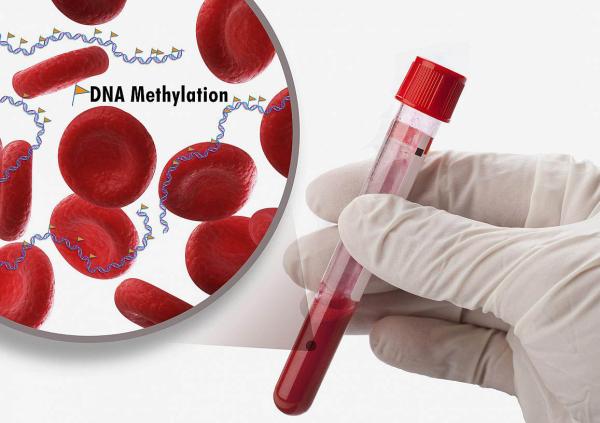A Step Towards Precision Medicine for Lupus
IRP Research Hints at Potential of Genomic Technologies to Predict Patient Outcomes

A new IRP study identified differences in chemical tags on DNA — called methylation — in lupus patients whose symptoms improved after treatment compared to those whose symptoms persisted.
Our genes certainly have a huge influence over our risk for disease, but they don’t operate in a vacuum. Rather, they’re decorated with numerous molecular tags like a bejeweled bracelet, and these ‘epigenetic’ markers affect how genes behave. A recent IRP study revealed differences in certain epigenetic markers that may one day help doctors more effectively treat patients with the autoimmune disease known as lupus.1
Like all autoimmune diseases, lupus occurs when patients’ bodies begin attacking their own tissues and organs. However, not all such illnesses are as complicated — and therefore tough to treat — as lupus is. Doctors frequently struggle to figure out the best course of treatment for individuals with the disease, and the longer that process takes, the more likely a patient is to experience significant damage to their organs before the disease is brought under control.
“We know we can bring all these people together under the big lupus umbrella, but there’s a lot of variation in how one patient with lupus presents versus another one,” explains the new study's senior author, Cristina Lanata, M.D., a staff clinician in the lab of IRP adjunct investigator Lindsey A. Criswell, M.D., M.P.H. “One patient might have a rash on their skin and some joint pain, and others have multi-organ failure, and we still don’t understand why there can be such large differences in outcomes.”
“There’s this joke that when people don’t know what disease they have, it’s lupus,” adds IRP postdoctoral fellow Mary Horton, Ph.D., M.P.H., the study’s first author. “It’s so complicated, and that makes it so challenging to try to understand.”
The new study Drs. Horton and Lanata led was born of an interest in using genomic tools to speed up the trial-and-error process often involved in lupus treatment, or even bypass it entirely. The research focused on a type of epigenetic marker called DNA methylation, which often — but not always — dampens how active a gene is.
“It influences how a cell is going to read the genetic code,” Dr. Lanata explains. “A liver cell doesn’t need to read the chapter for the brain cell, so it will close that chapter, and part of that is adding this methylation marker to certain DNA.”

In different people, the same location in DNA may have differing amounts of methylation, which influences how each individual’s DNA behaves.
The IRP researchers began by measuring the methylation at thousands of sites in the DNA of people experiencing a sudden increase in their lupus symptoms, known as a disease flare. They also measured DNA methylation in the patients roughly three months later, in addition to assessing the severity of their symptoms. Symptoms had largely resolved by the second visit for 19 of the study’s 59 participants, and the amount of DNA methylation on nearly 2,000 genes changed differently for those people over the previous months compared to the patients whose symptoms stuck around.
“The thing that stood out to me was that the people who didn’t get better had pretty much no change in these methylation sites at all,” Dr. Horton says. “This is interesting because, when you experience a flare, the way to try to resolve it is to change your medication, so all of these people had a medication change, but only 19 of them actually got better, and it was only those people who had any change at these methylation sites.”
The IRP team also found that DNA methylation differences could be used to separate the patients into three distinct groups with similar methylation changes over the course of the study. Intriguingly, all 12 members of one of these groups saw their symptoms go away between the study’s two timepoints, despite the fact that the groupings did not factor in patients’ symptoms at all. With additional investigation, it may eventually be possible to use such methylation-based groupings to more quickly pair lupus patients experiencing a flare with the optimal treatment, since there might be distinct biological mechanisms driving symptoms in each group.

Dr. Cristina Lanata (left) and Dr. Mary Horton (right)
“Right now, in clinical practice, we go through a Russian roulette of medications,” Dr. Lanata says. “We start with one, we wait several months, and if it doesn’t work we go to plan B. We have to wait a long time, and sometimes only on the third or fourth try the person responds to a treatment. It would have been nice to just have started with that treatment and not have gone through a trial-and-error period that could last a year or more.”
Much more research is needed before reaching that point, however, including doing a similar DNA methylation analysis in patients enrolled in some kind of clinical trial that provides them all with the same medication, rather than the variety of different treatments the IRP study provided participants. Such a study would eliminate many variables and make it easier to link specific DNA methylation changes with improvements in specific symptoms. Eventually, such studies may yield a ‘precision medicine’ approach to treating lupus flares, providing much more individualized treatment plans to address the many flavors of lupus.
“Our main objective here was to figure out whether DNA methylation is a useful tool to help us with all these difficult questions,” Dr. Lanata says. “I think we’ve shown it has great promise to do so based on this initial study, but there’s a lot of legwork left to do.”
Subscribe to our weekly newsletter to stay up-to-date on the latest breakthroughs in the NIH Intramural Research Program.
References:
[1] Horton MK, Nititham J, Taylor KE, Katz P, Ye CJ, Yazdany J, Dall'Era M, Hurabielle C, Barcellos LF, Criswell LA, Lanata CM. Changes in DNA methylation are associated with systemic lupus erythematosus flare remission and clinical subtypes. Clin Epigenetics. 2024 Dec 18;16(1):181. doi: 10.1186/s13148-024-01792-x.
Related Blog Posts
This page was last updated on Tuesday, February 25, 2025
